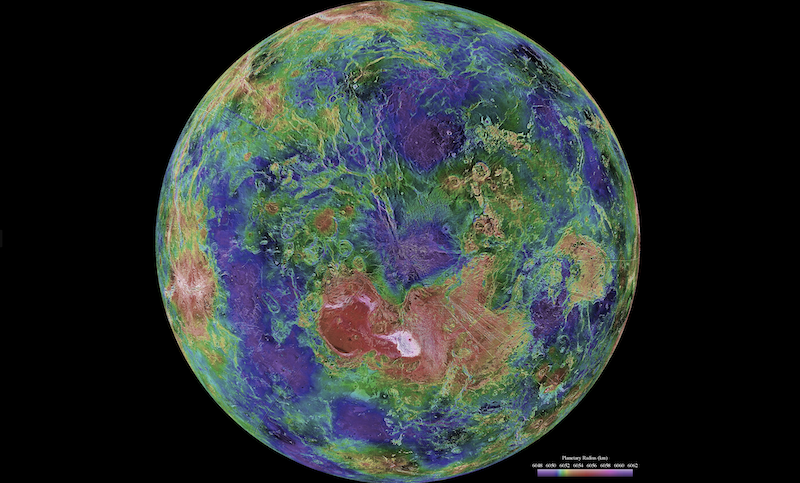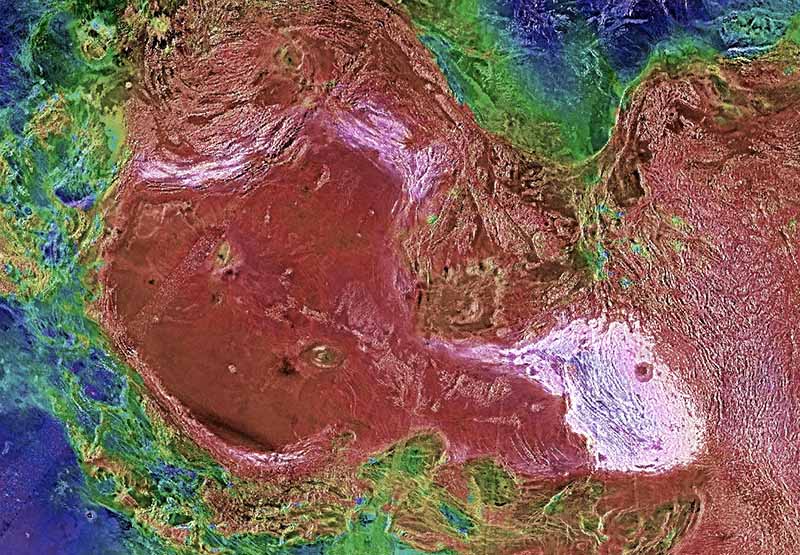
- Venus has large plateaus called tesserae, and a new study suggests that they formed through processes similar to those that created early continents on Earth.
- But Venus doesn’t have plate tectonics, which played a key role in continent- and mountain-building on Earth. So scientists are surprised!
- The new study focused on Ishtar Terra, the 2nd-largest tessera on Venus. It’s about the same size as Australia.
Venus doesn’t have oceans. So it doesn’t have continents in the same sense that Earth does. But it does have vast plateaus called tesserae, which are akin to continents. Now a new study suggests the tesserae might have more in common with Earth’s continents than previously thought. Researchers said on August 2, 2024, that both Venus tesserae and early earthly continents on Earth could have formed through similar processes, even though Venus does not have plate tectonics, the process that, on our world, creates both continents and mountain ranges.
The research team, led by Fabio Capitanio from the Monash University School of Earth, Atmosphere and Environment, published its peer-reviewed findings in Nature Geoscience on August 2, 2024.
‘Continents’ on Venus challenge planetary knowledge
Since Venus lacks plate tectonics, the findings were a surprise for planetary scientists. Scientists didn’t expect Venus to have such complex geological processes, like the ones that gave rise to continents on Earth.
Capitanio said:
The study challenges our understanding of how planets evolve. We did not expect Venus, with its scorching 460 degrees Celsius (860 F) surface temperature and lack of plate tectonics, to possess such complex geological features.
The study focused on one tessera in particular, called Ishtar Terra, in the northern hemisphere. It is the second largest of the major plateaus on Venus, comparable in size to Australia. The researchers used computer simulations to see what the region was like billions of years ago.

Similarities to early continents on Earth
The researchers said that Venus’ tesserae may have formed through geological process quite similar to the ones that produced the earliest continents on Earth. Those continents began as ancient cratons, the oldest parts of Earth’s continental crust. Cratons are the stable interior portions of continents, typically composed of ancient crystalline basement rock. In the cratons, the rock is older, denser and stronger. Overall, there are about 35 known cratons on Earth.
Scientists say they formed first, pushing upward through Earth’s molten interior. They then hardened, becoming the cores of what are now the modern continents.
Capitanio added:
This finding provides a fascinating new perspective on Venus and its potential links to early Earth. The features we found on Venus are strikingly similar to Earth’s early continents, suggesting that the dynamics of Venus’ past may have been more similar to Earth’s than previously thought.

Divergent evolutionary paths
Scientists say that Venus was once much more Earth-like and possibly even had oceans. But something happened, and Venus and Earth then took very different evolutionary paths. The new results can provide more clues as to how these two worlds became so different. On Venus, the findings suggest that the divergence began after the cratons formed but before plate tectonics could start.
This can help scientists better understand how rocky planets like Venus and Earth form and evolve. It also provides clues about how a rocky planet could develop and maintain habitability, like Earth, or end up becoming uninhabitable on its surface, like Venus. So, by studying Venus’ history, scientists can learn more about Earth’s as well. As Capitanio noted:
By studying similar features on Venus, we hope to unlock the secrets of Earth’s early history.
Bottom line: A new study suggests that ‘continents’ on Venus, vast plateaus known as tesserae, may have formed in a very similar way to early continents on Earth.
Source: Ishtar Terra highlands on Venus raised by craton-like formation mechanisms
Read more: Does phosphine on Venus mean … life?
Read more: Active Venus volcanoes revealed again in Magellan data











